Lifeboat Foundation AlienShield
By David Brin, Richard K. Graf, Alexei Turchin, Philippe Van Nedervelde, and other members of the Lifeboat Foundation Scientific Advisory Board. This is an ongoing program so you may submit suggestions to [email protected].
Let’s be careful and not cause this to happen!
Overview
As any alien race able to reach us is likely to be considerably more advanced than us, we would do well to develop a communications and diplomatic protocol to minimize any frictions caused by a first contact situation, be it friendly, unfriendly or neutral. In particular, we would discourage actions which could all too easily be misinterpreted as overtly hostile such as preemptively scrambling — let alone launching — nuclear weapons during a possible first contact. The rule when engaging in contact with an alien race is to do anything possible to avoid war since we are quite likely to lose.
This program will be devoted to developing the first contact protocol.
In addition to this protocol, we should be careful about any devices that we are told to construct via alien messages, as such devices could be unfriendly AI or other harmful devices. If such a danger is suspected, this warning must be immediately made public knowledge to discourage others from activating possible alien weapons.
Finally, we are against any efforts to on purposely provide our technological level and location to potentially hostile aliens. (So we are against METI and in favor of SETI.)
First Contact Protocol
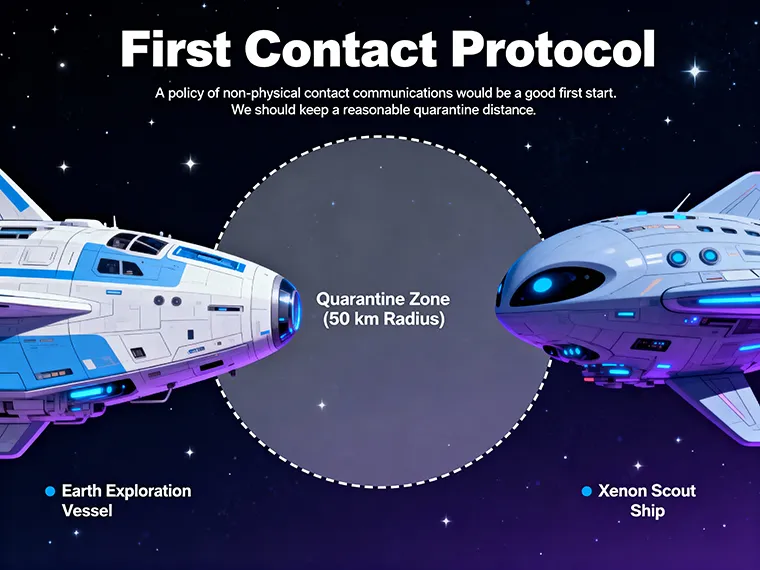
A policy of non-physical contact communications would be a good first start. We should keep a reasonable quarantine distance until a level of trust has been established.
Communication Types
Methods of communicating include mathematical languages, pictorial messages, multi-modal messages, and algorithmic messages.
Mathematical Languages
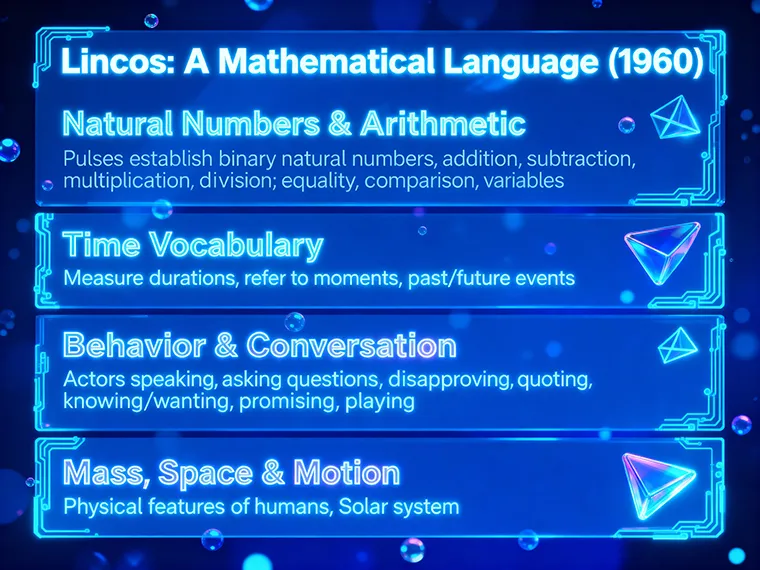
An example of a mathematical language is Lincos, published in 1960 by Hans Freudenthal, which created a general purpose language derived from basic math and logic symbols.
The Lincos “dictionary”, intended to be transmitted first before any additional messages, begins with a simple pattern of pulses intended to establish the terminology for natural numbers and basic arithmetic (addition, subtraction, multiplication and division) in base two. The concepts of equality, comparison, variables and constants are also illustrated by a series of examples, and then finally propositional logic, set theory and first-order logic.
The next section of the Lincos dictionary establishes vocabulary for describing time, introducing means for measuring durations, referring to moments in time, and talking about past and future events.
The third section is perhaps the most complex, and attempts to convey the concepts and language necessary to describe behavior and conversation between individuals. It uses examples to introduce actors speaking to each other, asking questions, disapproving, quoting other people, knowing and wanting things, promising, and playing.
Finally, the fourth section describes the concepts and language relating to mass, space, and motion. This last section goes so far as to describe physical features of human beings and of the Solar system.
Pictorial Communication Systems
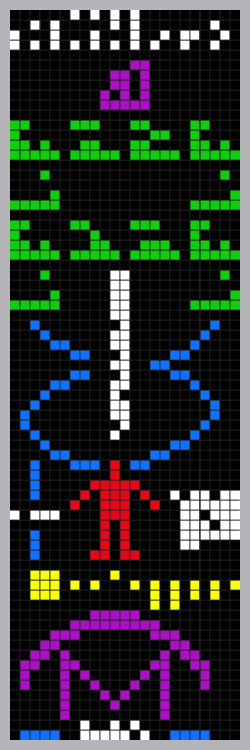
Colorized version of Arecibo
Message
Pictorial communication systems seek to describe fundamental mathematical or physical concepts via simplified diagrams sent as bitmaps. These messages assume that the recipient has similar visual capabilities (weak assumption) and can understand basic math and geometry (strong assumption because both are prerequisites for building the optimal shape for a radio or optical telescope). A common critique of these systems is that they assume a shared understanding of special shapes, which may not be the case with a species with substantially different vision, and therefore a different way of interpreting visual information.
An example of a pictorial message is the Arecibo message, transmitted in 1974, which was a 1679 pixel image with 73 rows and 23 columns.
Reading from left to right and from top to bottom, it states (or shows) the following:
- the numbers one (1) through ten (10);
- the atomic numbers of the elements hydrogen, carbon, nitrogen, oxygen, and phosphorus;
- the formulas for the sugars and bases in the nucleotides of Deoxyribonucleic acid (DNA);
- the number of nucleotides in DNA;
- a graphic of the double helix structure of DNA;
- a graphic figure of a man and the dimension (physical height) of an average man;
- the human population of Earth;
- a graphic of the solar system, i.e. Earth’s solar system; and
- a graphic of the Arecibo radio telescope and the dimension (the physical diameter) of the transmitting antenna dish.
The yellow graphic of the solar system is shown from left to right, showing the Sun and the planets in the order of their position from the Sun: Mercury, Venus, Earth, Mars, Jupiter, Saturn, Uranus, Neptune, and Pluto.
The Earth is the third planet from the Sun — its graphic is shifted up to identify it as the planet from which the signal was sent.
In addition to showing position, the graphic provides a general, not-to-scale size reference of each planet and the Sun.
Another example of a pictorial communication system is the Voyager probes, launched in 1977, which carried two golden records that were inscribed with diagrams depicting the human form, our solar system and its location. Also included were recordings of pictures and sounds from Earth which actually made this a multi-modal message.
Multi-Modal Messages
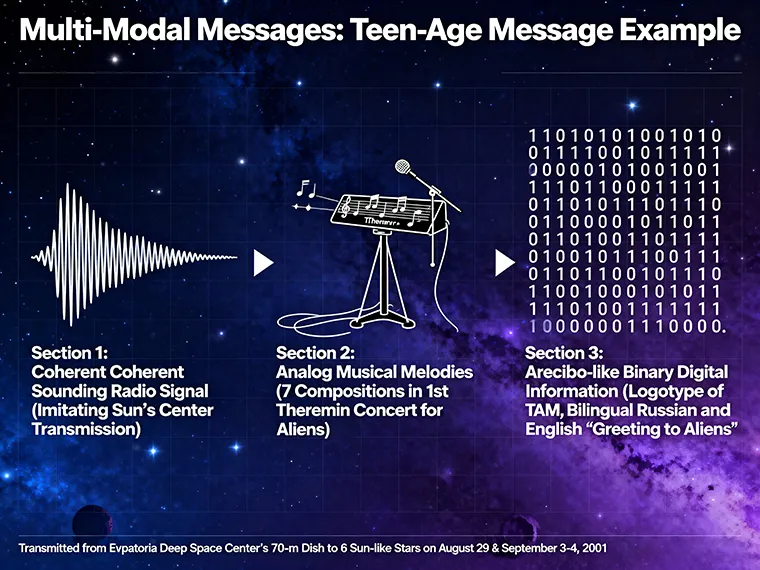
An example of a multi-modal message is the Teen-Age Message, composed by Russian scientists (Zaitsev, Gindilis, Pshenichner, Filippova) and teens, was transmitted from the 70-m dish of Evpatoria Deep Space Center to six Sun-like stars on August 29 and September 3 and 4, 2001. The message consists of three parts:
- Section 1 represents coherent sounding radio signal with slow Doppler wavelength tuning to imitate transmission from Sun’s center. This signal was transmitted in order to help Extraterrestrials detect the TAM and diagnose the radio propagation effect of interstellar medium.
- Section 2 is analog information and represents musical melodies, performed on the Theremin. This electric musical instrument produces quasi-monochromatic signal, which is easily detectable across interstellar distances. There were seven musical compositions in the 1st Theremin Concert for Aliens.
- Section 3 represents a well-known Arecibo-like binary digital information: Logotype of TAM, bilingual Russian and English Greeting to Aliens and Image Glossary.
Algorithmic Communication Systems
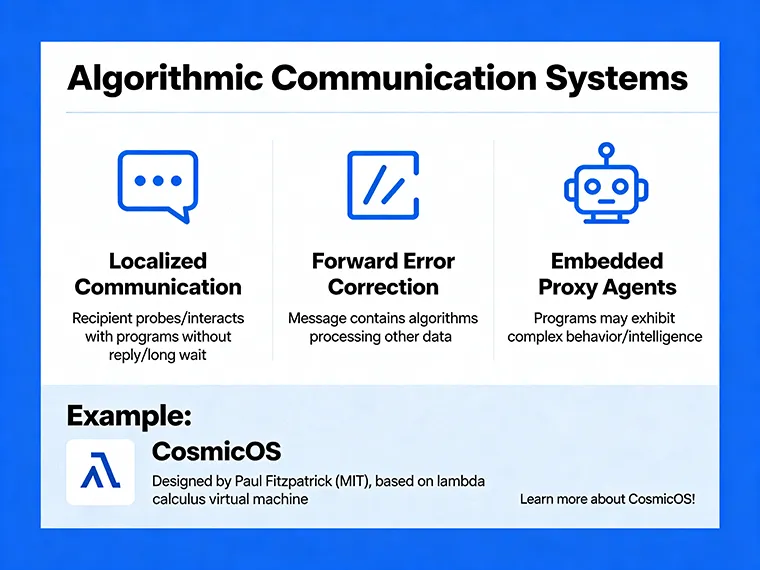
Algorithmic communication systems are a relatively new field. In these systems, which build upon early work on mathematical languages, the sender describes a small set of math and logic symbols that form the basis for a rudimentary programming language that the recipient can run on a virtual machine.
Algorithmic communication has a number of advantages over static pictorial and mathematical messages, including: localized communication (the recipient can probe and interact with the programs within a message, without transmitting a reply to the sender and then waiting years for a response), forward error correction (the message might contain algorithms that process data elsewhere in the message), and the ability to embed proxy agents within the message. In principle, a sophisticated program when run on a fast enough computing substrate, may exhibit complex behavior and perhaps intelligence.
An example of an algorithmic communication system is CosmicOS, designed by Paul Fitzpatrick at MIT, which describes a virtual machine that is derived from lambda calculus. Learn more about CosmicOS!
Establishing Communication
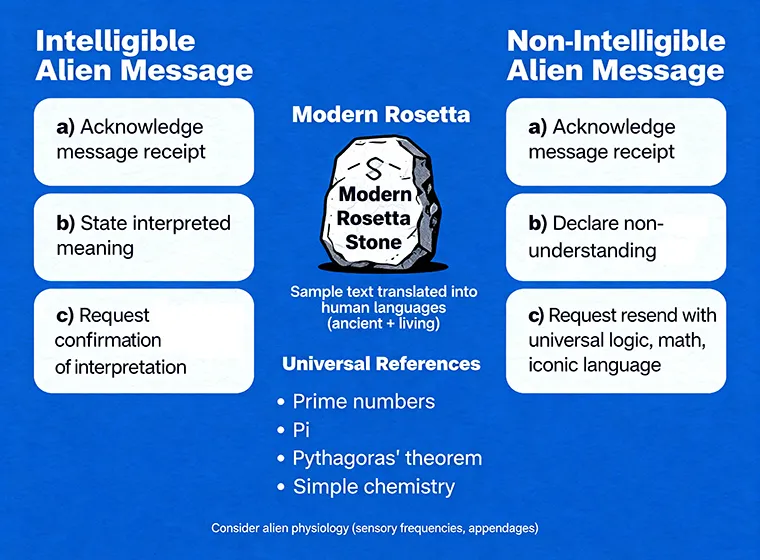
Starting cases include: alien message intelligible and alien message not intelligible.
If intelligible, then the answer depends very much on what we believe the message says… which suggests the answer may include a) acknowledgement of receipt of the message; b) what we believe the message to mean; and c) request to confirm that our interpretation is accurate and if not for them to rephrase the message.
If not intelligible, then we want to send a message which says (in a variety of ways that we think they might understand, informed by elements from their message) a) acknowledgement of receipt of a message; b) declarations in various forms that we did not understand the message nor any parts of it; and c) request to resend the message, but perhaps in a more complete form, or to send us a different message using elementary logic, mathematics involving universal constants, and an elemental iconic language.
As soon as we have any kind of contact which is unintelligible to us, we should send them the modern equivalent of the Rosetta stone: a sample of text translated into most human languages — living languages as well as ancient ones.
To establish communication it will be necessary to create a common reference from which further discussions could be conducted. We recommend that a list of “Universal” references be created that could be used to form a basis for further efforts.
A demonstration of prime numbers and universal mathematical concepts, such as Pi, Pythagoras and various other mathematical formulas, and then a exchange of simple chemistry would be a good start.
There is no reason to necessarily expect that our new “friends” would have evolved in an environment that would have lead them to evolve the abilities to either see or hear in the same frequencies that we do. If the physiology of the aliens is sufficiently different we may not possess the appendages or organs to make easy communications possible.
Humans are very visual creatures. Even if there is a language barrier between us we can usually gesture and point and eventually get another human to understand what we are trying to convey. (Galactic charades anyone?) If contact is made physically then one could attempt to use the tried and true finger pointing “Me Tarzan” method of establishing a common reference.